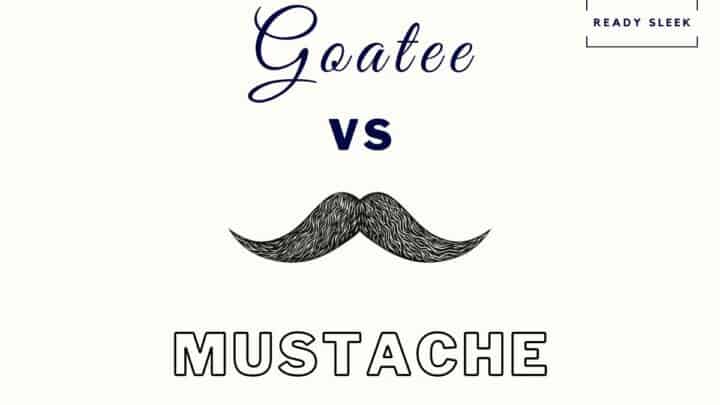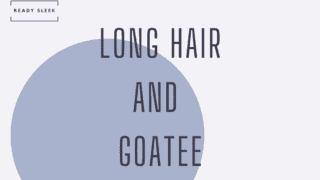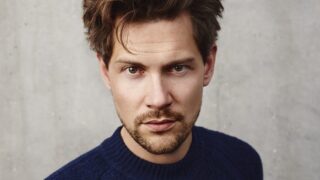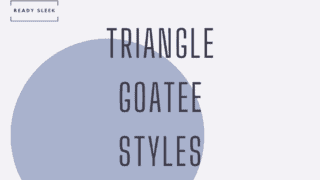Goatee vs mustache. It’s a battle that’s raged on for as long as man has walked this planet. Well, at least the 1940s anyway. So, how do you choose between wearing a goatee or a mustache?
Mustaches are better suited to men with “longer” faces that may be elongated even further by goatee styles. They’re also, in general, a little lower maintenance than goatees.
However, goatees do seem to be more popular at the moment, with mustaches often appearing as more of a retro throwback. Due to the fact that they’re so common, goatees are also generally considered more versatile.
That’s the answer in a nutshell, but I wanted to go so much deeper. The main difficulty with choosing between the two is that people really aren’t clear what the difference is.
Definitions have been blurred over the decades and people have confused themselves to the point of dizzying nausea. I wanted to clear things up in one fell swoop.
I’ll first lay out the difference in pretty spectacular fashion. Then, I’ll swiftly and effectively tell you how to choose between the two.
Enough with the bickering – let’s settle this.
Goatee vs Mustache – What’s The Difference?
A “goatee” is any facial hairstyle where there is hair on the chin but not on the cheeks, while a “mustache” is facial hair that’s grown immediately above the upper lip.
It’s important to note that goatees can sometimes incorporate mustaches in the overall style.
Most of the confusion surrounding this topic is due to the unclear definition of the term “goatee”.
The problem is that the answer is very much dependent on who is asked. But the most helpful definition of a “goatee” is, once again, “a style consisting of hair on the chin but not on the cheeks.”
Essentially, if there’s hair on the cheeks, it’s not a goatee.
It’s also helpful to classify “goatees” into “classic goatees” and “full goatees”. There are many other variants, but broadly speaking, these are the biggest.
A “classic” goatee consists of hair on the chin and nowhere else. A “full” goatee consists of hair on the chin, as well as a mustache. The chin beard and mustache are usually connected. If they aren’t, it becomes a disconnected goatee style.
That’s right – many goatee styles include a mustache. Although this may not fit into the traditional, purist definition of a goatee, most modern goatees do indeed include a mustache.
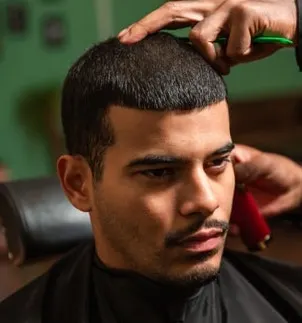
(From Shutterstock)
Again, as long as there is no cheek hair, you’re good.
To summarize, if someone simply has “a mustache”, they’ve got hair on their upper lip and probably nowhere else.
But if they’ve got a “goatee”, they’ve got hair on their chin and not on their cheeks. This may or may not include a mustache (upper lip hair) as well.
Easy.
Goatee Vs Mustache: How To Choose Effectively
To choose between these two admirable facial hairstyles it’s important to know what factors are important to you. As you’d expect, the answer will definitely vary according to what men prioritize.
I’ve outlined five factors worth strongly considering before committing to a specific style. That might sound a little too dramatic – if you don’t like one just shave it off and try the other one.
But still, this could potentially save you from a minor inconvenience. Your welcome.
1. Face Shape
It’s hardly a secret that face shape plays a huge role in determining your ideal facial hairstyle.
Although this is quite a broad topic in itself, it can be simplified by presuming the following; an oval-shaped facial structure is generally considered appealing.
Of course, this is a pretty vast generalization. What one may find “appealing”, another may find “hideous”. Attractiveness is so subjective, but it isn’t worth getting into that argument.
In general, using facial hair to give the illusion of having an oval-shaped face is very commonly done. The reason for this is that it works.
Men with round faces benefit from goatees because the hair on the chin acts to elongate the face. This can give structure to an otherwise shapeless face.
Goatees also benefit square-shaped men because the absence of hair on the cheeks acts to soften the broadness of the jawline.
Of course, men with oval faces are blessed with the option of wearing whatever facial hairstyle they’d like. A goatee would definitely suit them too. Having said that, so would a mustache.
There are certain face shapes that would definitely benefit from a mustache as opposed to a goatee. These include any face shapes which are typically considered “long” and would seem even longer due to a goatee being present.
Long face shapes include rectangular, triangular, and diamond-shaped faces. These shapes lend themselves far better to mustaches than to goatees.
2. Maintenance requirements
The simple answer to this would be “the more hair you have, the more maintenance it’ll need”. But that isn’t helpful, or entirely accurate.
Maintenance can be split broadly into trimming and grooming. I use the term “grooming” to refer to any aspect of facial hair maintenance that isn’t trimming. This includes oiling, balming, waxing, and so on.
Yes, a goatee will most likely require more trimming than a mustache. There are just more edges to worry about lining up and a larger shape to worry about making symmetrical. Plus, you’ve got a neckline to define as well.
You’ll also most likely have more general grooming habits to adhere to with a goatee. This is because you’ll probably have more hair to deal with in general.
But the maintenance requirements of a mustache largely depends on the complexity of the mustache style itself.
For example, a “handlebar” mustache usually just requires a trim, comb, and balming or waxing to curl the edges.
Compare this with the Fu Manchu – it’s on a different level of difficulty and maintenance requirements. I’ve used a vanishingly rare style to illustrate my point, but I hope you get what I mean.
Having said this, overall, the mainstream mustache styles are generally easier to maintain than the most common goatee styles. If ease of maintenance is a factor that’s important to you, this is definitely something to strongly take into consideration.
3. Maintenance Cost
The cost of maintaining facial hair once again depends mainly on the specific style, as well as the length.
There are so many beard grooming products available on the market today it can be quite overwhelming. It could be argued that not all of them are entirely necessary. Do you really need so many different types of balms and pomades?
That’s a different argument, however.
It’s just important to know which ones could benefit your specific style and meet your specific needs.
Goatees are generally short and quite simple, although not always. They usually don’t require the use of many grooming products. A good trimmer and some beard oil could go a long way, however.
Longer goatee styles would most likely benefit from a boar bristle beard brush.
The cost of maintaining a mustache also depends on the specific mustache style. If you’re rocking The Horseshoe or The Walrus, you’ll probably want to invest in a comb.
If your objective is a dazzling Handlebar, you’d probably need some good mustache balm or wax, as well as a comb.
As you can see, the cost of maintenance depends on the type of goatee and the type of mustache. The cost can add up either way.
I’d put goatees and mustaches on a level playing field when it comes to cost, for that reason.
4. Cultural Trends
As is the norm with style and fashion, beard and mustache trends tend to wax and wane over time. 20 years ago, the facial hair you would’ve most commonly seen on a day-to-day basis was different.
Currently, longer beard styles are in trend. Goatees probably aren’t as popular as they were in the ‘90s, and neither are mustaches.
Having said this, at present, you’d be much more likely to see a goatee than a mustache in most Western societies. A lot of “what’s popular” in society is dictated by the media, whether consciously or subconsciously.
Goatees are worn by numerous modern-day celebrities – athletes, singers, rappers, actors, etc. This definitely does have a cultural impact and effects how likely we are to see the style in everyday life.
Mustaches aren’t as common as they were in the ‘80s. They’ve fallen out of favor among some, but there are still those who choose to swim upstream. Tom Hardy is a good example, frequently wearing the mustache with stubble and doing so quite spectacularly.
But in general, it would be hard to deny that goatees are more popular than mustaches at the moment. Considering the volatility of men’s grooming trends, this may well be different a few years from now.
But if awareness of cultural trends is important to you, this is just something to bear in mind as you make your decision.
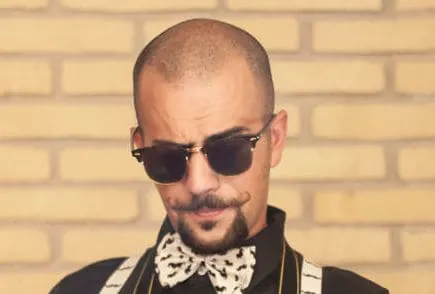
[From 123RF]
5. Versatility
The “versatility” of a style is how easily it would fit into different situations and contexts. Is it casual enough, formal enough, comfortable enough, etc.
It’s hard to deny that not every facial hairstyle would be suitable for every environment. There are those of you that may disagree, but try rocking a Ducktail or braided goatee to investment banking interview.
But when it comes to the goatee vs mustache battle, which one wins when it comes to versatility?
Goatees are arguably some of the most versatile facial hairstyles known to man. They’re just so universally accepted that there aren’t really any contexts in which they would be considered “unacceptable”.
They’re usually small, short, well-defined, and neatly trimmed. Everything you’d want in a multi-purpose beard.
Longer goatee styles are not as common but are still pretty prevalent. These may not be as versatile, but they’d still get you around without much trouble at all.
Mustaches can also be very versatile, but once again this is very dependent on the style itself. Due to mustaches not being as common and often considered more of a retro throwback, I’d say goatees would win the versatility contest.
Not by much, however.
Goatee Vs Fu Manchu: What’s The Difference?
While a “goatee” could refer to any facial hairstyle where there is hair on the chin but not on the cheeks, the Fu Manchu is a mustache where there are two long “tendrils” that extend from the corners of the lips down past the chin.
Contrary to popular belief, the upper lip is clean-shaven, with the tendrils originating from the edges.
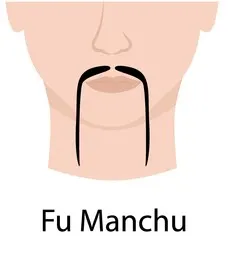
This is what differentiates the Fu Manchu from the Horseshoe mustache which does have hair all across the upper lip and down to the chin. It creates that famous inverted U-shape or “horseshoe” shape we know and love.
You don’t often see Fu Manchu mustaches, but when you do it certainly is memorable. They’re pretty intricately associated with villainous characters from art, movies, and TV.
Goatees and Fu Manchus are two very different styles. The main difference is, of course, the absence of hair on the chin with most Fu Manchus. This, by definition, makes it a non-goatee style.
However, there are certain men who have a “third tendril” that extends from a patch on the chin. Technically, as there are two tendrils extending from above the lip and one tendril from the chin, this could theoretically be called a disconnected goatee style.
Having said this, most Fu Manchu mustaches don’t have this third tendril and make do with the two.
Ultimately, goatees are way, way more common than Fu Manchus in both Western and Eastern culture these days. The Fu Manchu mustache would be a reasonable option for any looking to make a pretty significant statement and draw some serious attention.
It’s a classic mustache style that isn’t anywhere anytime soon.
Frequently Asked Questions
I thought I’d use this section to consolidate the most important parts of this article. These questions are commonly asked and there just aren’t enough clear answers online at the moment.
Is A Goatee A Beard Or A Mustache?
A goatee should always be considered a beard. It’s a beard consisting of hair on the chin but not on the cheeks. The goatee may or may not also include a mustache which simply refers to the hair above the upper lip.
A facial hairstyle which only consists of hair above the upper lip should simply be called a mustache and nothing else.
Although the definitions can take some of the fun and spontaneity out of facial hair grooming, they really do help you understand the different styles.
What Is A Goatee Without A Mustache Called?
Well, a goatee without a mustache should simply be called a goatee. To be more specific, it could be called a “classic” goatee, or a “traditional” goatee.
This is because the traditional definition of a goatee doesn’t actually include a mustache. The original “goatee” was simply a tuft of hair on the chin and nowhere else. There was no hair above the upper lip.
Back in the 1940s and ‘50s, this was very common.
But when the ‘90s came around, the term “goatee” usually referred to the beard that encircled the mouth. In other words, a chin beard and mustache that may or may not be connected.
Although it may not seem too important, there are certainly men that passionately feel that a true goatee should only consist of hair on the chin. This is an argument for another day.
Is There a Middle Ground I Can Try?
A disconnected goatee style consists of a mustache and a chin beard that aren’t connected. There is a very distinct gap between the two components.
These styles are very popular and combine the majesty of a goatee with the sophistication of an isolated mustache. The Van Dyke is a good example. I’ve written an article on the goatee vs the Van Dyke you can check out if you’d like.
If you’re finding it hard to choose between the two styles, why not try a dazzling combination of both of them?
Conclusion
When deciding whether to go for either a goatee or a mustache, a bit of experimentation can go a long way.
Try one, then the other. Try variants of each, with different styles, different lengths, using different products.
You’ll eventually land upon something you love and want to wear all the time. Something you’re so proud of you don’t mind the extra effort required to groom and maintain it.
Ultimately, that’s the aim of facial hair grooming in general. To find the style that suits you so well that it’s impossible to fathom how you’d lived without it for so long.
Trust me, it’s there. It’s just a case of finding it.
Ready Sleek founder. Obsessed with casual style and the minimalist approach to building a highly functional wardrobe. Also a fan of classic, vintage hairstyles.

